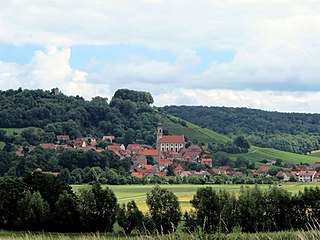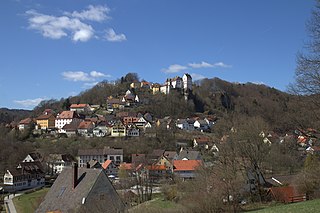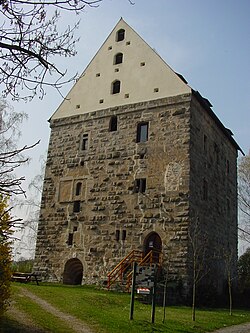Erlangen-Höchstadt is a Landkreis (district) in Bavaria, Germany. It is bounded by the districts of Fürth, Neustadt (Aisch)-Bad Windsheim, Bamberg, Forchheim and Nürnberger Land, and by the cities of Nuremberg and Erlangen. The city of Erlangen is not part of the district, but nonetheless its administrative seat.

Neustadt an der Aisch is a small town of around 13,000 inhabitants in the northern part of Bavaria (Germany), within the Franconian administrative region Middle Franconia. It is the district town of the district Neustadt (Aisch)-Bad Windsheim.

Kulmbach is the capital of the district of Kulmbach in Bavaria in Germany. The town, once a stronghold of the Principality of Bayreuth, is renowned for its University of Life Sciences, a branch of the University of Bayreuth, the massive Plassenburg Castle, which houses the largest tin soldier museum in the world, for its brewery, its vivid food industry, which hosts some of the world's biggest food businesses, and for its sausages, or Bratwürste.

The Principality of Bayreuth or Margraviate of Brandenburg-Bayreuth was an immediate territory of the Holy Roman Empire, ruled by a Franconian branch of the Hohenzollern dynasty. Since Burgrave Frederick VI of Nuremberg was enfeoffed with the Margraviate of Brandenburg in 1415/17, the Hohenzollern princes transferred the margravial title to their Franconian possessions, though the principality never had been a march. Until 1604 they used Plassenburg Castle in Kulmbach as their residence, hence their territory was officially called the Principality of Kulmbach or Margraviate of Brandenburg-Kulmbach until the Empire's dissolution in 1806.

Casimirof Brandenburg-Bayreuth was Margrave of Bayreuth or Margrave of Brandenburg-Kulmbach from 1515 to 1527.

Bad Berneck im Fichtelgebirge is a spa town in the district of Bayreuth, in Bavaria, Germany. It is situated on the White Main river, in the Fichtel Mountains, 13 km northeast of Bayreuth. It lies in the northern part of the Bavarian province of Upper Franconia. Since 1857 it has been a spa, initially based on its climate and whey products. In 1930 it became a Kneipp spa and, in 1950, a Kneipp health spa.

Ebermannstadt is a town in the district of Forchheim, in Bavaria, Germany. It is situated 10 km northeast of Forchheim and 25 km southeast of Bamberg.

Breitengüßbach is a community in the Upper Franconian district of Bamberg in Bavaria. It was first mentioned as Gusibach and as belonging to the royal court at Hallstadt in an Imperial document issued between 812 and 830.

Burgebrach is a market town in the Upper Franconian district of Bamberg and the seat of the administrative community (Verwaltungsgemeinschaft) of Burgebrach.

Buttenheim is a market town in the Upper Franconian district of Bamberg and lies in the Regnitz Valley between Bamberg and Nuremberg, Germany.

Heroldsberg is a municipality in the district of Erlangen-Höchstadt, in Bavaria, Germany. It is located eleven kilometers north-east from the city of Nuremberg and 23 kilometers east from Erlangen and is the headquarters of Schwan-Stabilo.

Röttenbach is a town in the district of Erlangen-Höchstadt, in Bavaria, Germany.

Castell is a municipality in the district of Kitzingen in Bavaria in Germany. It was the seat of the Counts of Castell. Today it is part of the municipal association Wiesentheid. It has around 800 inhabitants.

Gerhardshofen is a municipality in the district of Neustadt (Aisch)-Bad Windsheim in the administrative region of Middle Franconia in northern Bavaria in Germany.

Illesheim, founded 1283 AD, is a municipality in the district of Neustadt (Aisch)-Bad Windsheim in Bavaria in Germany. The earliest leader affiliated with Illesheim's foundation was Götz von Berlichingen, known as "the Knight with the Iron Hand." Also known locally as "Illesa". It lies 6 kilometers west of Bad Windsheim and 11 kilometers east of the A7 motorway.

Uehlfeld is a municipality in the district of Neustadt (Aisch)-Bad Windsheim in the administrative region of Middle Franconia in northern Bavaria in Germany.

Weigand of Redwitz was Prince-Bishop of Bamberg from 1522 until his death.

Egloffstein Castle is a former high mediaeval, aristocratic castle, that stands immediately west of the eponymous village of Egloffstein in the Upper Franconian county of Forchheim in the German state of Bavaria.

Schloss Kunreuth is situated on the northwestern edge of the eponymous village of Kunreuth which is part of the collective municipality of Gosberg in the county of Forchheim, in the province of Upper Franconia in the south German state of Bavaria.
Horst Weigelt (1934–2024) was a German Protestant theologian. From 1975 to 2002 he was Professor of Historical and Systematic Theology at the Otto Friedrich University of Bamberg. His research focuses on the Reformation, Pietism and Enlightenment in the early modern period. He also wrote specifically on Schwenkfelders.























